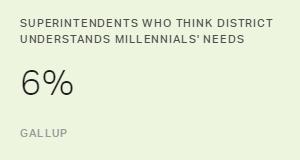It’s no secret that hanging onto employees has become increasingly challenging in the last three years. Education leaders know that teachers are no exception, with 40% of university faculty and staff saying they are either actively or passively looking for a new job.
Moreover, many departing educators are leaving the profession altogether.1 What’s more, interest in the teaching profession among high school seniors and college freshmen has declined by 50% since the 1990s.2 This all means that the talent pool is getting smaller by the day.
Leaders may feel powerless in retaining teachers, especially with budget constraints and a hybrid or remote setup isn’t an option. But the challenge isn’t necessarily a pay or lack of work flexibility problem; teachers are feeling overworked and undervalued, leading to burnout, dissatisfaction and disengagement.
Forty-four percent of K-12 education employees report feeling burned out either “always” or “very often,” the highest among U.S. workforce groups. College or university employees follow at 35%, with the gap widening. Burnout hinders engagement -- and burned out employees are 2.6 times as likely to be actively seeking a different job, and 13% less confident in their performance.
So the question becomes: What can education leaders do to lessen turnover and retain their teachers?
Have Meaningful Conversations
When leaders don’t check in regularly with their teachers about how they’re feeling and what’s going on, it leaves room for teachers to feel unheard or treated unfairly.
Employees who agree that they are often treated unfairly at work are 2.3 times more likely to experience a high level of burnout. Unfair treatment can include perceived favoritism, lack of development opportunities and lack of recognition -- all indicative of feeling undervalued. These issues often stem from a lack of transparency, accessibility and trust between teachers and their superiors.
To address this, education leaders should prioritize having meaningful conversations that create opportunities for leaders to listen to teachers’ concerns and problems and provide recognition or meaningful feedback focused on performance, goals, and strengths. Gallup recommends that those who lead teams of people engage in at least one meaningful conversation per week with each employee, as it is essential to building engagement and effective relationships.
How does having meaningful conversations play out in education? Maybe your school already has the infrastructure in place where teachers report to department heads or other staff -- maybe not. However, if your teachers don’t have someone investing in them on a consistent, personal level, they may miss opportunities to discuss crucial issues like their development, engagement and wellbeing.
Gallup’s workplace research shows that employees whose manager is always willing to listen to their work-related problems are 62% less likely to be burned out. By building trust and giving time, education leaders can demonstrate care for their teachers, reducing perceptions of inequity. Moreover, when workplace issues arise, teachers are more comfortable addressing their feelings with their superiors rather than letting concerns linger.
Communicate Expectations Better -- And More Often
The education workplace has undergone significant changes in recent years, underscoring the increased importance for leaders to communicate frequently and effectively with teachers. Only 46% of teachers strongly agreed that they received a clear job description.3 While orientation is an important stage for role clarification, the evolving nature of roles and expectations in the workplace requires regular communication. It’s also an easy way for leaders to reiterate the rationale behind decisions, initiatives and changes, connecting teachers to the bigger picture.
To address this, education leaders should prioritize having meaningful conversations that create opportunities for leaders to listen to teachers’ concerns and problems and provide recognition or meaningful feedback focused on performance, goals, and strengths.
When fundamental engagement elements are met (providing clear expectations and the materials and equipment needed to do work right), it empowers teachers to do what they do best every day. This means education leaders need to be aligned in their vision and provide clear, concise, and frequent communication about their school’s expectations, goals, and progress.
Ask Questions and Listen
Burnout intensifies when teachers face workplace stress without the resources to cope in a healthy manner. That’s why it’s so important for education leaders to support teachers, listen to their needs and offer encouragement at both the personal and collective levels. This lets teachers know that someone supports them when challenges arise, providing a psychological buffer against stress.
By building trust and giving time, education leaders can demonstrate care for their teachers, reducing perceptions of inequity.
One way education leaders can foster a supportive environment is by actively seeking teachers’ opinions and ideas. Creating an environment where everyone’s opinion counts promotes buy-in, inspiring a sense of ownership and inclusion among teachers. This gives teachers a greater feeling of control over their work, diminishing the feeling that work is happening to them.
Give Recognition
Giving frequent, meaningful recognition reinforces the importance of teachers’ contributions. Acknowledging achievements and milestones demonstrates that leaders notice, support and value their teachers.
Recognition doesn’t always need to be formal. For example, school leaders witnessing exceptional work or dedication to the job can send a quick email to the staff recognizing the specific talents or strengths they saw.
This means education leaders need to be aligned in their vision and provide clear, concise, and frequent communication about their school’s expectations, goals, and progress.
Quick, meaningful recognition doesn’t need to be complicated. It starts by asking people how they want to receive it or by learning what types of appreciation carry the most weight for them personally. A Gallup and Workhuman study4 found that only 10% of employees report being asked about their preferences for receiving recognition, and the education industry is no exception to the lack of individualization and authenticity that can happen when recognition isn’t done right.
Above all, leaders should individualize teachers’ experiences on the job. When employees feel their contributions matter, are recognized, and are making a difference, they feel more appreciated and engaged.
Think About Your Institutional Culture
Leaders can support engagement and stifle burnout on a large scale by actively promoting a culture of engagement and wellbeing throughout their school.
Employees who say they have the opportunity to do what they do best every day are 57% less likely to frequently experience burnout. Additionally, employees who know and use their strengths are six times as likely as other employees to be engaged and to say they do what they do best every day.
Many schools and districts are already using CliftonStrengths to foster engagement and wellbeing among educators. Introducing CliftonStrengths lets leaders help teachers understand their unique strengths, giving them opportunities to apply them while teaching. In addition, awareness of colleagues’ strengths helps develop meaningful collaboration among teachers, deepens connections between staff and students, and helps cultivate a strengths-based school culture.
Giving frequent, meaningful recognition reinforces the importance of teachers’ contributions.
Successful institutions also use their culture’s unique elements to promote teacher engagement and wellbeing.
Culture is a proactive measure, meaning that the more you focus on the elements that are important to your school’s success, the less you’re tied to dramatic changes in the education landscape.
A strong institutional culture reinforces the mission behind why your school exists, guards against recurring issues like burnout, and establishes an environment where current and future teachers want to work.
Just look at how engaged employees describe their workplace compared to actively disengaged employees.5
Why Retaining Teachers Matters
From a financial perspective, retaining teachers proves more cost effective than onboarding new hires annually. But, the consequences of teacher burnout and turnover are significant and extend beyond financial considerations.
Those who say they very often or always experience burnout at work are 63% more likely to take a sick day and 23% more likely to visit the emergency room.
Addressing turnover goes beyond avoiding the negatives. Gallup research shows that when leaders strive to build teacher engagement and wellbeing, it creates an improved student experience.
And teachers who are engaged are 62% less likely to leave their district, compared with teachers who are not engaged or are actively disengaged.
But perhaps most important is that educator burnout doesn’t just affect teachers -- it affects students. High teacher burnout and turnover rates create an unstable environment for students, negatively influencing teacher-student connections and resulting in learning loss due to difficulty sustaining curriculum initiatives and curricular consistency.
At a precarious time in education, it only makes sense to invest in your teachers by encouraging their engagement, development and wellbeing. The return on investment isn’t just lower turnover -- it’s thriving educators and thriving students.
Retain and develop your star educators:
- Discover the keys to improving teacher retention and burnout.
- Learn how to improve commitment to your workplace by engaging faculty and staff.
- Use CliftonStrengths to empower and develop your most promising educators into top performers.




